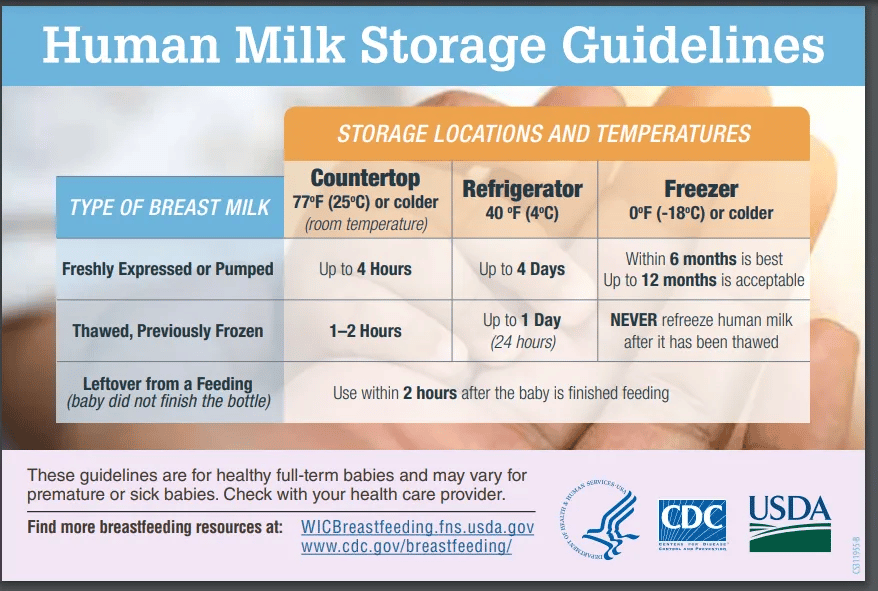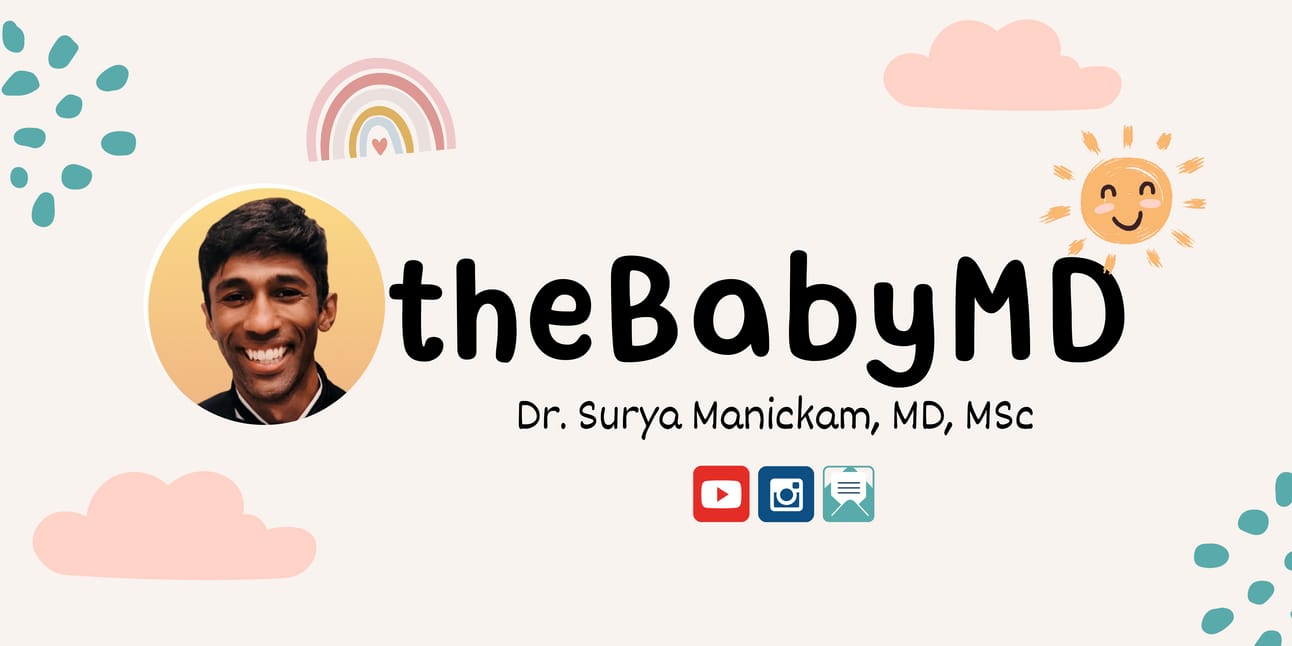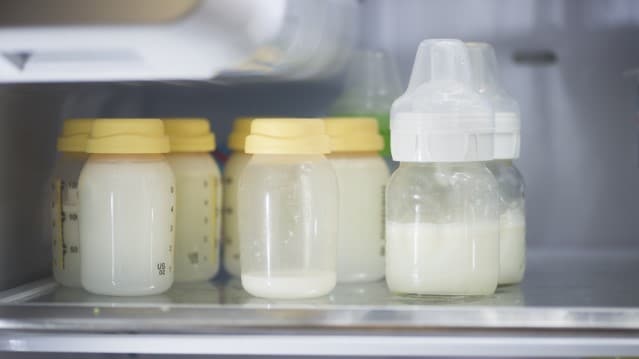- theBabyMD
- Posts
- Welcome to theBabyMD Newsletter!
Welcome to theBabyMD Newsletter!
Thank you so much for joining thebabyMD community! In today's newsletter, we will cover my mission for this community, and the topic of breastfeeding & feeding your baby. Hope you enjoy!
❤️ My Mission
My name is Surya Manickam, and I’m a pediatrician and NICU doctor.
I’m starting this community to give parents more access to medical information and help you all feel a little more confident when caring for your baby at home. I’m sharing my advice through Instagram, TikTok, YouTube, and now a newsletter.
I trained at Brown for medical school, completed my pediatric residency at Columbia University, and now I’m at Children’s Hospital Los Angeles as a fellow, to specialize in the NICU (neonatal ICU). My wife and I live in LA together.
Before I became a doctor, I was a mental health coach where I supported hundreds of individuals through their social anxiety. That experience shaped my love for listening, counseling, and supporting others—skills I now use everyday in the NICU. For many families, having a baby in the NICU is a moment of crisis, a detour from the vision they had bringing their baby home. My greatest joy is helping parents find strength, clarity, and hope during these crazy moments.
This community is a natural extension of who I am and my work. Through each video and newsletter, my mission is to educate and support you in your parenting journey. So please feel free to ask me questions, share your thoughts, and let me know what topics you’d like to review. I would really appreciate it if you could like and share our videos, so we can expand our reach to our other parents. Thank you for joining me here, and I’m excited to support your parenting journey!
📣 My Channels
You can find our content for thebabyMD on:
💡This Week’s Topic: Breastfeeding and Feeding
For this week’s topic, we are going to cover some common questions on breastfeeding and feeding your newborn.
Feeding Your Newborn - 3 Things to Know
#1: In the first 2-3 months of life, you should be feeding your baby roughly 2-3 ounces, every 2-3 hours. This includes AT NIGHT. The amount they feed will be lower in the beginning of life, and that’s expected.
#2: Your baby can feed as often as they’d like and as much as they’d like. So while we want them to feed at least every 2-3 hours, they can feed much more often if they’d like, and that’s okay.
#3: When it comes to breastfeeding vs formula feeding, having your baby fed is the most important thing. Breastmilk has so many benefits, so it is what we as pediatricians recommend, but there are so many reasons why parents choose formula and choosing formula is absolutely fine. Having your baby fed is the most important thing.
For more details on feeding your baby, please check out our YouTube channel below https://youtu.be/MT4m8sSa-74?si=PJbxf1uIxhQyItmQ
How long can I store breastmilk after I pump?
So immediately after you pump:
If you leave your breastmilk in room temperature (on the counter), it can last up to 4 hours before it may spoil
In the refrigerator, it can last up to 4 days
And in the freezer, it can last up to 12 months, though using the breastmilk within 6 months is best
After you thaw your frozen breast milk,
It can be left in room temperature, for about 1-2 hours before it may spoil
If you feed your baby from a bottle and they don’t finish it all, try to use that breastmilk within 2 hours.
In the refrigerator, it can last up to 1 day
You should never refreeze breastmilk after it’s been thawed from the freezer
Lastly, here is a helpful table from the CDC summarizing everything mentioned above.

Tips for storing breastmilk:
#1: Clearly label the date and time you pumped your breastmilk before you put that container of breastmilk in the fridge or freezer.
#2: If you don’t think you’ll use the breastmilk within 4 days, freeze it as soon as you can to maintain it’s nutritional quality
#3: When freezing breastmilk, store small quantities at a time, like 2 ounce bottles, that way no breastmilk goes to waste. This is because, once you unfreeze breastmilk, you should never refreeze it
4: Always thaw and use the oldest breastmilk first. The older the breastmilk becomes, the lower its nutrition value is. So you want to use the milk as soon as you can.
How do I store breast milk while traveling?
You can store breast milk in an insulated cooler bag for up to 24 hours.
As soon as you get access to a refridgerator, refrigerate it or freeze it. It can last up 4 days in the fridge or up to 6-12 months in the freezer
On a flight, remember you can carry as much breastmilk as you need. You’re exempt from the TSA 3.4 fl oz rule. You can even bring ice packs and gels with this exception
What are the safest ways to warm breastmilk?
So you can just let the breastmilk naturally thaw and warm to room temperature. But if you do actively rewarm it, keep these tips in mind. This does take some time, so make sure you plan ahead.
First, keep it in a sealed container
Second, place this container in a bowl of warm water for around 20 minutes
Third, test the milk by placing a few drops on your wrist to make sure it’s not too cold
Fourth, swirl the breastmilk since sometimes the fat separates
And fifth, DO NOT microwave the breastmilk or heat it on a stove top since it can decrease the quality of the nutrients and unevenly warms the milk. Since the primary benefit of breastmilk is all the nutrients, microwaving/stovetop really does defeat the purpose. So it’s best to follow the instructions above.
Should I use ready-to-feed formula or powdered formula?
So every mom should purchase formula before their baby is born that way, if breastfeeding ever doesn’t go well for a feed, you have formula as a back up to still feed your baby.
Which brings us to our options: Ready-to-feed formula vs. powdered formula.
Ready-to-feed formula is formula that you can immediately and directly feed your baby. There is no mixing with water required. They are more expensive though and, once opened, must be refrigerated and consumed within 48 hours
Powdered formulas, on the other hand, come in a container and required to be mixed with water. They are more affordable and honestly work great for full term babies and other babies who don’t have any other medical conditions. After you mix it, it lasts up to 24 hours in the refrigerator. So this is what I usually recommend for babies when they go home.
When can I give my baby whole cow’s milk?
At 12 months of age is when you can first transition from formula to whole cow’s milk.
But it’s first important to remember that the AAP recommends breastfeeding until age 2 years or beyond, if mother and baby are able to and interested in doing that.
However, for the many families who aren’t able to breastfeed for that duration of time, 12 months old is when you can transition from any infant formula you’re giving your baby to whole cow’s milk. It’s important its whole cow’s milk, rather than 2% or 1%, because your baby still needs that higher amount of fat. They can transition to skim milk at 2 years of age.
Once you do switch over at 12 months old, it’s important you don’t give your baby more than 24 oz of milk per day. With these higher amounts of milk, your baby may not eat as much, decreasing their overall nutrition and red blood cell levels.
To undershoot this number, and based on your feeding schedule, I usually recommend to give 6-8 oz of milk in the morning to ease your baby into the day and 6-8 oz of milk at night, to ease your baby into their time to sleep.
Disclaimers: All of the opinions we express are of our own and not of any of our prior or current institutional affiliations. The information we share is primarily for babies born full term (over 37 weeks gestation) and without any medical issues. So please speak with your pediatrician so they can tailor these recommendations best for your baby. All the information presented above is for educational purposes and should not be taken as personal medical advice.
Thank you for reading! Please feel free to share this newsletter with anyone who made find it useful.
Best,
Dr. Surya Manickam, MD, MSc


